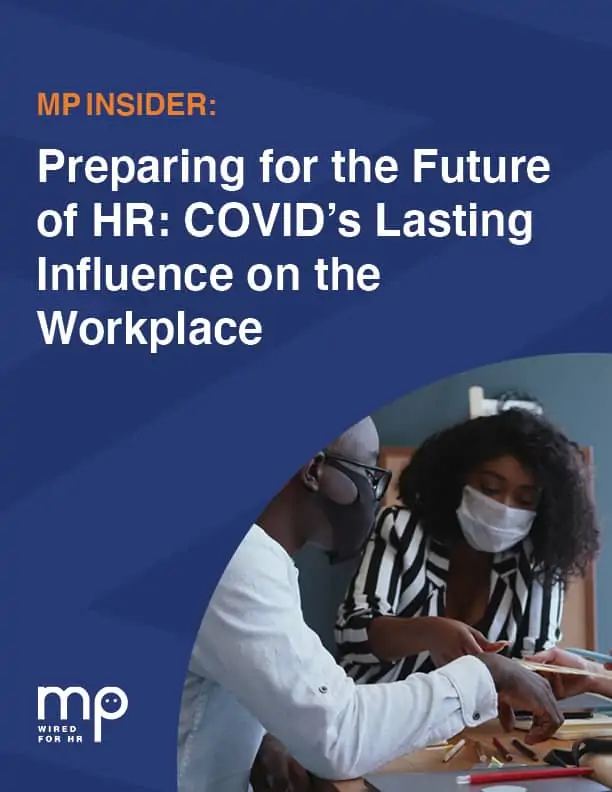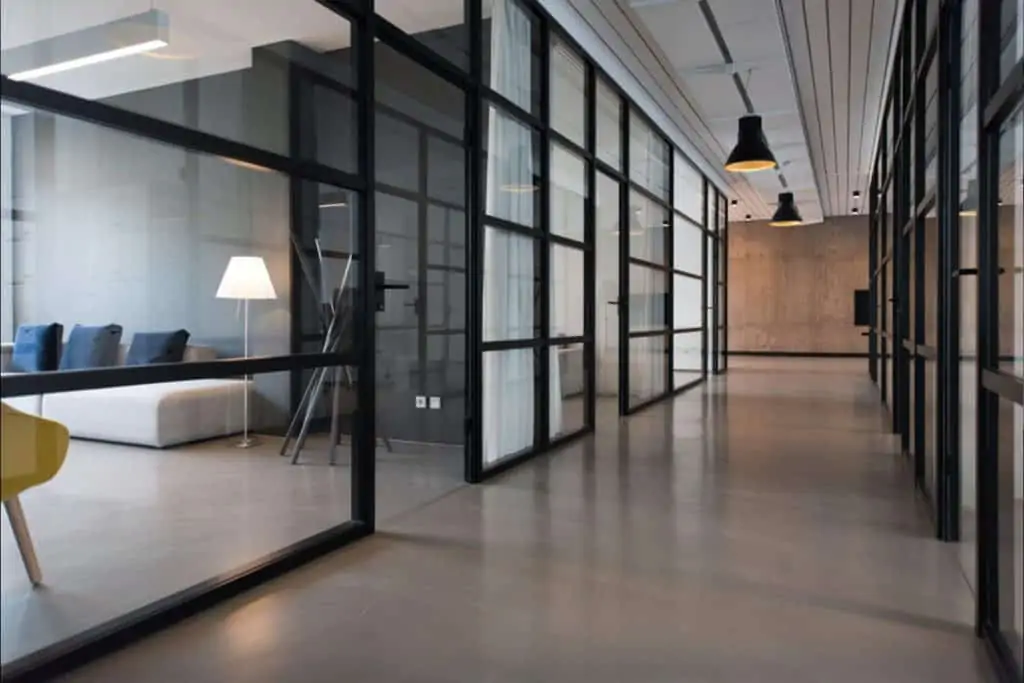Posted on September 23rd, 2020
Preparing for the Future of HR: COVID’s Lasting Influence on the Workplace

MP INSIDER:
Preparing for the Future of HR: COVID’s Lasting Influence on the Workplace
Table of Contents
- New Employee Policies for Remote Work
- Preparing for Onboarding Remotely or in Hybrid Forms
- 3 Tips to Foster Employee Engagement in a COVID Environment and Beyond
- 8 Key Trends in Office Layouts
- Social Distancing: The End of ‘Water Cooler Chat?’
Introduction
2020 will be an unforgettable year for many reasons, but it’s certainly going down in history as the year that work, as we know it, changed drastically and permanently. Across every industry and vertical, workers and management alike have experienced at least some change in the way they work now. This is an unfamiliar work environment, where it’s common for new hires to never meet their teammates in person, and a casual lunch with colleagues won’t be happening for a while. The MP team has been on the front lines of many of these changes, assisting businesses, schools, healthcare organizations, and nonprofits as they pave the way for their future. Read on to learn about the changes that HR and payroll departments of all industries will need to be tackling in 2020 and beyond. This eBook will also cover the best HR strategies for gracefully implementing changes into the workplace and the company employee handbook.

New Employee Policies for Remote Work
Remote work is on its way to becoming a new norm. Many companies are even considering transitioning 100% of their workforce to a remote plan. Some businesses and nonprofits are evaluating a hybrid plan, with either some staff working remotely and others in person, or all staff working a schedule with a combination of remote and in-person days.
Because remote job descriptions will become so widespread, it’s becoming imperative for employers to keep up if they want to retain talent or attract new team members. Allowing remote work, whether hybrid, 100% remote, or intermittent plans, will require workplaces to create a solid, official telecommuting policy.
7 Key Questions you Need to Ask Before Developing a Telecommuting Policy:
- Who can work remotely?
Whose job descriptions could support remote work, even if they haven’t before? Review all job descriptions so that you’re not inadvertently discriminating against certain kinds of jobs, departments, sexes, etc. Consider if you’ll require an application process to move people’s roles to remote, or you’ll just do it upon request. Then, make sure to change job descriptions as needed.
- What will be the expectations for hours and availability?
Will you require core hours, allow alternative schedules, etc.?
- How will you foster communication and collaboration?
How will you hold meetings? How will employees turn in their work? How will people reach out if they have questions or want to discuss something with a colleague or manager?
- How will you track attendance and hours?
This is especially important when it comes to non-exempt employees. They’re responsible to report hours worked per day and you, as the employer are required to pay them for every hour. You must also figure out the procedure by which non-exempt employees will request and obtain approval for overtime. HR software like MP’s can streamline this process and eliminate the potential for errors.
- Who will pay for equipment?
Your remote work policy should explicitly cover how workers will pay for the equipment they need to complete their work. Some states, like California, mandate that the employer pays for required equipment. It’s also worth noting that some companies are providing employees with a stipend to pay for remote work costs. One example is Shopify, who has given their employees a $1,000 stipend to pay for costs related to working from home.
- How will you track equipment?
Because you will be loaning out or reimbursing workers for laptops, phones, headsets, or other expensive equipment, you’ll also need it back one day if your employees take a role with a new employer. Your company should utilize a system to track this equipment, so everyone knows what needs to be returned later. Again, HR software like MP’s is excellent for tasks like this one.
- What skills will your workers need if they’re working remotely?
When your team works remotely, you may require them to use chat tools, Skype, or other technology for collaboration. To complete daily duties, your staff may need to video chat during internal meetings or with clients. It’s important to make decisions about these protocols now, and to lay them out in your employee handbook for reference. This way, nobody is surprised by new remote work requirements later. Your company can also use remote training software to keep your workers updated on the skills they’ll need to do their jobs—remotely or in-person.
“There are pieces of HR that are going to change drastically but I think for the better. The silver lining in what’s happening is that there will be a focus on engagement and performance management. We’re returning to a more performance managed approach that is focused on results rather than at what time an employee punches in and out.“
Sheri Heller, PHR, SHRM-CP, MEd
Preparing for Onboarding Remotely or in Hybrid Forms
As workplaces shift to remote or hybrid job descriptions, they’ll also naturally shift to remote onboarding. While this change can seem radical, employers are finding that it’s simple when you use the right technology and have clear priorities.

- I-9 requirements and beyond: Generally, you must physically inspect a new hire’s documents for their I-9 form within 3 days of the start date. However, due to COVID-19’s impact, this requirement has changed. Starting April 18th of 2020 and going until at least November 19th of 2020 (and perhaps further if it’s extended again), HR departments can digitally inspect a new hire’s documents if the company or organization is working in a largely remote capacity. They should write ‘COVID-19’ in the ‘Additional Information’ field. Upon returning to the workplace, the HR department will need to physically inspect the documents within 3 days. The HR professional should then add the date and ‘physically examined’ to the Additional Information field. While this remote accommodation for the I-9 form may not become permanent, it may inspire other similar changes in the laws and regulations that HR departments are subject to in the future.
- Introducing new hires to the team: Formerly, new hires were walked around the office to shake hands with colleagues and managers. Now, this practice will become digitized. Best practices include setting virtual meetings for new team members to get them acquainted with their colleagues and other departments. Companies may also set up virtual happy hours as a social introduction for new hires. In addition, employers will want to ensure that managers and teammates check in on new hires at a more frequent pace than they would in person. This will help make certain that new staff feels supported, gets their questions answered, etc. Another best practice is to consciously and specifically create a corporate culture in which everyone’s ‘door is open.’ New hires and current workers should be responsive to one another over email, chat, calls, etc. so that communication feels easy and encouraged—especially for new people (who are more likely to feel isolated).
- Technology for onboarding: While many companies had already switched to cloud-based HR solutions pre-pandemic, this method of operation is now frequently a necessity. Employees can fill out new hire paperwork, elect their benefits, and set direct deposits. Later, they can also go back and change things themselves whenever necessary. Additionally, companies can upload organizational charts (especially with pictures), so that new hires can see who is on their team and how to contact them. This technology doesn’t just assist in facilitating remote onboarding. It’s likely to remain long past COVID, an improvement upon the labor-intensive process that also left room for human error.
- Technology for training: Whether it’s a new hire, or a long-standing member of the team, it is highly likely that some component of training will need to be conducted remotely. Training software, like MP’s, can be used to share trainings (both custom and pre-prepared), track employee progress, and keep a record of who is up-to-date and/or has relevant certifications. The software also allows users to download, print out, and share certificates for completed trainings.
A learning management system (LMS) provides flexibility to staff, facilitating training at any time. Workplaces may use training software whether their workers operate remotely or not because of a few advantages. Firstly, it saves time and money. Employers won’t need to hire a trainer or pull somebody away from their own job duties to train. Secondly, this software will guarantee that trainings are standardized. The information relayed will always be the same, no matter the recipient. As mentioned in the onboarding software section, the room for human error is deeply mitigated.
3 Tips to Foster Employee Engagement in a COVID Environment and Beyond
Even if your team won’t be moving to remote work, improving employee engagement will be handled differently because of COVID. Here are some items workplaces should consider:
1. Organize virtual gatherings:
Team building activities, happy hours, parties, and outings will be different for the foreseeable future. Stay abreast of state mandates about group sizes. Ensure that employees feel comfortable declining invitations to social activities. Managers should explicitly state that they understand if staff don’t feel comfortable joining for gatherings. Companies could hold Zoom, Skype, and Microsoft Teams happy hours if their workforce is completely remote.
2. Implement technology solutions:
Employee engagement technology fosters better collaboration and communication, both digitally and if a team is socially distanced in the office. Additionally, workplaces can use surveys to take the pulse on how employees are feeling. MP’s HR software allows users to do both, either anonymously or named. Even after implementing the right technology, it’s imperative to adapt the idea of an open-door policy to the internet. Ideally, colleagues and reports will feel comfortable reaching out to people as needed.
3. Revisit mental health benefits:
To support their workers, employers can reduce or eliminate copays on telehealth visits. They can also make sure benefits packages include access to mental health specialists. Lastly, employers can offer a mental health day to all staff. To make this an effective policy, it’s important that employees don’t feel stigmatized using it. Employers can ensure this by having managers publicly take their own mental health days, thus setting the right tone.
8 Key Trends in Office Layouts
Numerous companies are operating remotely right now, but some will eventually return to operations in the office. When they do, office layouts will look very different for a long time. Here are 8 ways office layouts will change.
1. Reduction of employees and square footage:
The number of employees operating out of the office and the square footage, which will reduce significantly with less staff to accommodate. If workplaces aren’t planning to go 100% remote, they are frequently downsizing office space to cut real estate costs.
2. Dividers:
An increase in Plexiglass dividers and other kinds of barriers.
3. Distance:
More distance between workstations.
4. Workspace:
Desks and cubicles won’t be shared.

5. Standing desks:
To make it easier and cheaper to build barriers, standing desks (which are higher and thus will require higher dividers made of more material) will be a less frequent office fixture.
6. Health stations:
Stations for masks, hand washing, sanitizing, and health checks. Depending on the employer and location, employees can be required to do a temperature check and health screening before entry.
7. Conference rooms:
Conference rooms will be utilized less frequently. When they are used, seating will be arranged in a different way.
8. Air Circulation:
Changes to circulate more fresh air, using fans and opening windows.(COVID precautions will add a new element to the usual battles over office temperatures.)
Note: Employers must pay for time spent waiting to be screened and doing screenings. If employees are sent home, they may still need to be paid. If you have HR consulting, check in with them and create and share employee policies around these procedures before you run into issues.
Social Distancing: The End of ‘Water Cooler Chat?’
Beyond the physical layout of the workspace, employers will implement other procedures to create physical distance between employees. Social distancing will be necessary in some locations for as much as another year or two. Breaks and lunches will be staggered, and the water cooler will no longer be a social hub. Essentially, the biggest change in offices might not be the physical ones. They’ll be how anti-social the workplace now feels. It may beg the question for employers and staff alike: is returning to the workplace even worth it?
Trust MP to Help
MP has been a leading provider of HR and payroll solutions for companies across the US for nearly two decades. We offer a comprehensive suite of products and services delivered in one unified, easy-to-use platform. We support clients as they cultivate excellent corporate culture, improve employee engagement, and strive towards their business goals. Since 2014, MP has been on the Inc 5000 list and has won the Boston Business Journal Fastest Growing Companies Award.

